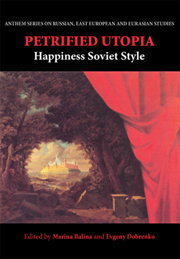Book contents
- Frontmatter
- Contents
- List of Illustrations
- Acknowledgments
- List of Contributors
- Introduction
- Petrified Utopia
- Part One Utopics
- 1 A Joyful Soviet Childhood: Licensed Happiness for Little Ones
- 2 Utopian Naturalism: The Epic Poem of Kolkhoz Happiness
- 3 Luxuriating in Lack: Plentitude and Consuming Happiness in Soviet Paintings and Posters, 1920s–1953
- 4 Tasty and Healthy: Soviet Happiness in One Book
- Part Two Realities
- Part Three Locations
- Notes
- Index
4 - Tasty and Healthy: Soviet Happiness in One Book
from Part One - Utopics
Published online by Cambridge University Press: 05 March 2012
- Frontmatter
- Contents
- List of Illustrations
- Acknowledgments
- List of Contributors
- Introduction
- Petrified Utopia
- Part One Utopics
- 1 A Joyful Soviet Childhood: Licensed Happiness for Little Ones
- 2 Utopian Naturalism: The Epic Poem of Kolkhoz Happiness
- 3 Luxuriating in Lack: Plentitude and Consuming Happiness in Soviet Paintings and Posters, 1920s–1953
- 4 Tasty and Healthy: Soviet Happiness in One Book
- Part Two Realities
- Part Three Locations
- Notes
- Index
Summary
They just now dragged themselves out of the houses in festive clothes, already having had time previously to down two or three glasses of vodka and snack on party food. Eddy-Baby knows that usually this is an ‘Olivier’ salad, sausages, and the customary sprats.
– Eduard Limonov, Adolescent SavenkoI will begin with a quotation from the radio dialogue between Petr Vail’ and Aleksandr Genis. Their conversation took place on Radio Svoboda airtime in now-distant 1989. The subject of the conversation was the same book that is now the subject of my analysis: the masterpiece of Soviet culinary science, the unforgettable, incomparable and celebrated The Book about Tasty and Healthy Food, promoted by the USSR People‘s Commissar of Food Industries, Anastas Mikoian.
Genis had this to say: ‘This book is an argument to the advantage of a sort of generalised Nina Andreeva, who, having become hydra-like, grows a new head every time to replace the one cut off.’
Hydras heads might well ‘fit’ Andreeva, a fierce perestroika opponent in 1988; but they also recall many other Ninas (maids, as well as housewives) who populated communal apartments and the collective Soviet memory, with their striving to stay in line with present trends and, accordingly, to master the most vital management of Soviet cookery, or to dream about it and about abundance despite their own social level.
- Type
- Chapter
- Information
- Petrified UtopiaHappiness Soviet Style, pp. 79 - 96Publisher: Anthem PressPrint publication year: 2009
- 2
- Cited by



